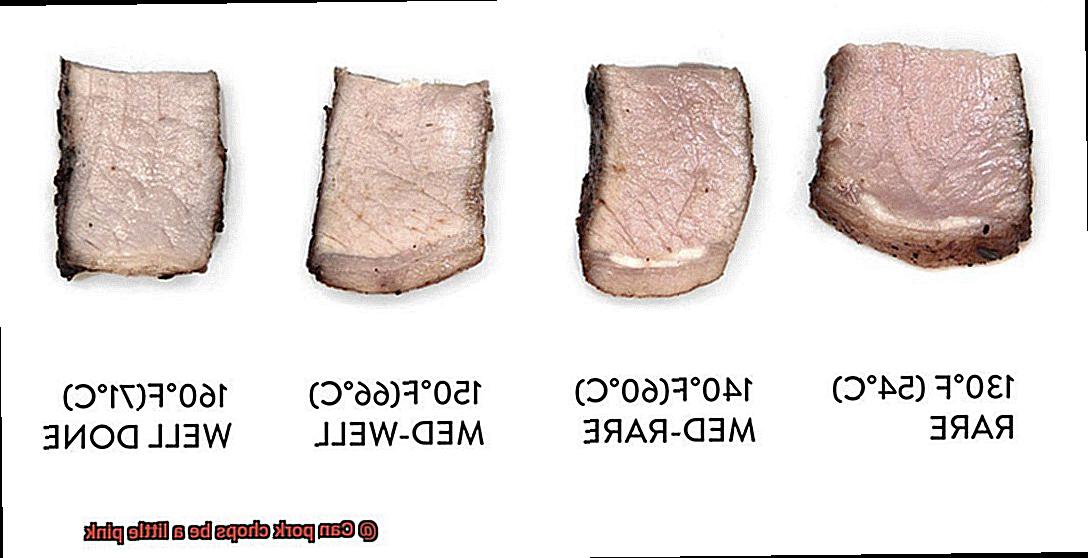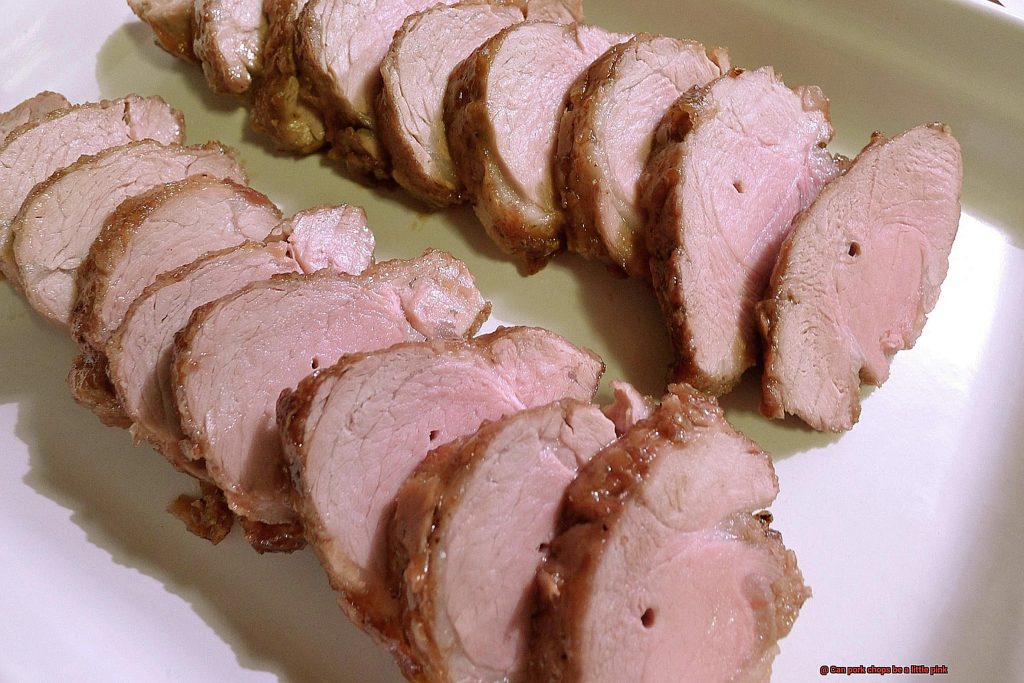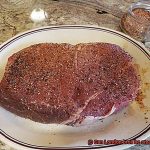Do you ever wonder if your pork chops are cooked to perfection? Perhaps you’ve noticed a hint of pink in the center and are unsure whether it’s safe to eat. Well, fret no more because we’re here to debunk the myth surrounding the age-old question: “Can pork chops be a little pink?”
Pork has long been thought of as a meat that must be cooked thoroughly to avoid foodborne illnesses. However, with advancements in food safety and production, this perception may not be entirely accurate.
The truth is that pork chops can have a little pink in the middle, depending on the internal temperature reached during cooking. The pink color comes from myoglobin, a protein found in muscles that turns red when exposed to oxygen. Therefore, cooking pork until it’s pale gray doesn’t necessarily mean it’s safe to eat.
This blog post will delve into the science behind cooking pork and explore the temperatures required to kill harmful bacteria. We’ll also discuss different cooking methods and factors to consider when determining doneness for pork chops. By the time you finish reading this post, you’ll have all the knowledge needed to ensure your pork chops are both perfectly cooked and safe to savor.
Contents
The USDA Guidelines on Cooking Pork Chops
Pork chops are a delicious and versatile protein, but it’s important to follow the USDA guidelines on cooking them to ensure they’re safe to eat. The USDA recommends cooking pork chops to an internal temperature of 145°F (63°C) and allowing them to rest for three minutes before serving. This temperature destroys any harmful bacteria in the meat, ensuring that it’s safe to consume.
While some people may worry about a slight pink color in their pork chops, it’s actually perfectly safe at this temperature. The pink color comes from a protein called myoglobin, which changes color from pink to brown as it cooks. In fact, a slightly pink center can be a sign that your pork has been cooked to perfection.
However, it’s crucial to use a meat thermometer to ensure that the meat has reached the internal temperature and has been maintained for at least three minutes. Relying on the color of the meat or cooking time alone can lead to undercooked pork and potential health risks.
If you prefer your pork chops well-done, you can cook them to a higher temperature of 160°F (71°C). However, be careful not to overcook them as this can result in dry and tough meat.
Can Pork Chops Be a Little Pink and Still Be Safe to Eat?
Pork chops are a staple in many households, but the question of whether they can be a little pink and still safe to eat is a common concern. As an expert, I have delved into this topic and found that the answer is not as straightforward as you may think.
It’s important to understand that pork needs to be cooked thoroughly to kill any harmful bacteria or parasites that may be present. However, this doesn’t mean that you need to cook your pork until it’s completely dry and well-done. In fact, cooking pork chops to an internal temperature of 145°F (63°C) is both safe and delicious.
The reason for this change in recommendation is due to advances in farming practices and food safety regulations that have significantly reduced the risk of contamination in pork. Not only is it safer to consume at lower temperatures, but overcooking pork can result in tough, dry meat that lacks flavor.
So, what should you keep in mind when cooking your pork chops? Here are some key points:
- Always use a meat thermometer to check the internal temperature of your pork chops. This will ensure that they reach the recommended safe temperature without being overcooked.
- While it’s okay for whole cuts of pork like chops to have a slight pink color at 145°F (63°C), ground pork and processed forms like sausage or bacon should still be cooked thoroughly until they reach 160°F (71°C) for safety.
- Let your pork chops rest for at least three minutes after cooking. This allows the juices to redistribute throughout the meat and ensures a more flavorful, tender result.
Why Does Pork Change Color As It Cooks?
The answer is simple – it’s all about myoglobin and heat. Let me break it down for you.
Myoglobin is a protein found in muscle tissue that gives meat its pink or reddish hue. As the pork heats up, myoglobin breaks down, denatures, and changes the color from pink to brown or white. So, if you notice your pork turning white or brown as it cooks, don’t worry; it’s perfectly normal.
But wait, there’s more. Heat also plays a significant role in changing the color of pork during cooking. High-heat cooking methods like grilling or broiling can cause the outside of the pork to brown quickly while the inside remains pink. However, this doesn’t mean that the meat is unsafe to eat.
Now, here’s the most crucial part – determining if your pork is cooked properly. The best way to do this is by using a meat thermometer. To ensure safe consumption, the internal temperature of cooked pork should reach 145°F (63°C). Therefore, always rely on a meat thermometer to avoid any undercooked or overcooked pork mishaps.
Finally, let your pork rest for at least three minutes before slicing or serving. This allows the juices to redistribute evenly throughout the meat, resulting in juicy and flavorful meat.
How to Ensure Your Pork Chops Are Cooked Properly

Pork chops are a delicious and versatile protein, but it’s important to ensure that they are cooked properly to avoid any risk of foodborne illness. By following these tips and tricks, you can guarantee that your pork chops are cooked to perfection every time.
Use a Meat Thermometer
To accurately determine whether your pork chops are fully cooked, it’s important to use a meat thermometer. Insert the thermometer into the thickest part of the chop, making sure not to touch the bone. Wait for the reading, and if it reads 145°F (63°C), your pork chop is safe to eat. This method of checking the internal temperature helps you avoid overcooking or undercooking your pork chops.
Marinate Your Pork Chops
Marinating your pork chops before cooking is another way to ensure that they are flavorful and moist. A marinade can be made using a variety of ingredients such as lemon juice, soy sauce, honey, or garlic. Marinating for at least an hour before cooking can help prevent your pork chops from becoming dry and tough while cooking.
Sear on High Heat
One of the secrets to perfectly cooked pork chops is searing them on high heat for a few minutes before finishing them in the oven or on the grill. Searing creates a crispy exterior while keeping the inside moist and tender. It also helps lock in the flavors and juices.
Cover with Foil While Resting
After cooking your pork chops, let them rest for a few minutes before serving to allow the juices to redistribute throughout the meat. To prevent them from drying out, cover them with foil while they rest. This step ensures that your pork chops remain juicy and tender by allowing the fibers in the meat to relax and reabsorb moisture.
Use the Touch Test
If you don’t have a meat thermometer, you can use the “touch test” to determine if your pork chop is cooked properly. Press down on the center of the chop with your finger and feel for resistance. If it feels firm and bounces back quickly, it’s likely cooked through. If it feels soft and squishy, it needs more time on the grill.
Wash Hands and Utensils Thoroughly
It’s essential to practice good hygiene when handling raw meat to prevent cross-contamination. Always wash your hands and utensils thoroughly before and after handling raw pork. This step helps prevent the spread of harmful bacteria that can cause foodborne illness.
The Importance of Using a Meat Thermometer
Not only does it ensure that they’re safe to eat, but it also makes a significant difference in their taste and texture.
Firstly, using a meat thermometer guarantees that your pork chops are cooked to the proper temperature. USDA guidelines dictate that pork must be cooked to an internal temperature of 145°F (63°C). This temperature is critical as it destroys any harmful bacteria or viruses present in the meat. Without a meat thermometer, you’re left guessing whether your pork chops have reached this temperature, which is why it’s such an essential tool for any home cook.
Many people assume that they can determine when their pork chops are done by looking at them. They might cut into the meat or squeeze it to test its firmness. Unfortunately, these methods are unreliable and can lead to overcooked, dry pork chops. Using a meat thermometer eliminates all the guesswork and ensures that your pork chops are always perfectly cooked.
Additionally, using a meat thermometer allows you to cook your pork chops perfectly without overcooking them. Many believe that pork must be cooked until there is no pink left in the center, but this isn’t accurate. As long as the pork has reached an internal temperature of 145°F (63°C), it’s safe to eat even if there’s a little pinkness in the center. In fact, cooking your pork to this temperature instead of overcooking it will make it much juicier and more flavorful.
When selecting a meat thermometer, there are countless options available. However, digital instant-read thermometers are the most reliable and straightforward to use. Insert the probe into the thickest part of the pork chop, being careful not to touch any bone, wait for a few seconds until the temperature reading stabilizes, then remove the thermometer from the meat. You’ll have perfectly cooked pork chops every time.
What Temperature Should You Aim For When Cooking Pork Chops?
First, start with room temperature meat. Take your pork chops out of the refrigerator and let them sit at room temperature for 15-30 minutes before cooking. This will ensure that they cook evenly throughout and avoid any cold spots.
Next up, choose your cooking method. Whether you prefer grilling, baking or pan-frying your pork chops, the most important thing is to keep an eye on the internal temperature of the meat. Use a meat thermometer and insert it into the thickest part of the chop to ensure it reaches 145°F (63°C).
Once your pork chops have reached this magic number, don’t forget to let them rest for a few minutes before serving. This will allow the juices to redistribute throughout the meat, resulting in a more tender and flavorful chop. Aim to let your pork chops rest for about 3-5 minutes.
In summary, here are the steps to achieving perfectly cooked pork chops:
- Take pork chops out of the fridge and let them sit at room temperature for 15-30 minutes.
- Choose your cooking method and use a meat thermometer to ensure internal temperature reaches 145°F (63°C).
- Let your pork chops rest for 3-5 minutes before serving.
How Long Should You Cook Your Pork Chops For?
If you’re wondering how long to cook your pork chops for, look no further. As an expert in the field, I’ve gathered some helpful information to ensure that your pork chops come out perfectly every time.
First and foremost, it’s crucial to cook your pork chops thoroughly to avoid any risk of foodborne illness. The USDA recommends cooking pork chops to an internal temperature of 145°F (63°C) followed by a three-minute rest time. This will ensure that harmful bacteria, such as E. coli or Salmonella, are destroyed.
The cooking time for pork chops varies depending on their thickness. A general rule of thumb is to cook them for 4-6 minutes per side on high heat. However, if you’re grilling thicker pork chops, you may need to increase the cooking time accordingly.
It’s essential to consider the color of your pork chop when cooking. Although some people prefer their pork chops with a little pinkness in the center, this is not recommended by health experts. The pinkness can be a sign of undercooked meat, which can lead to foodborne illness. Therefore, it’s best to cook the pork chops fully until there is no pinkness left in the center.
Lastly, don’t underestimate the importance of letting your pork chops rest before serving. Resting allows the juices to redistribute evenly throughout the meat, resulting in a tender and juicy chop. Aim to let them rest for at least 5-10 minutes before cutting into them.
Tips for Perfectly Cooked, Juicy Pork Chops Every Time
With these tips, you can achieve juicy and tender pork chops every time.
Use a Meat Thermometer
Cooking pork chops to the correct temperature is crucial for food safety and for ensuring that they are juicy and tender. Use a meat thermometer to check the internal temperature, which should reach 145°F (63°C). Insert the thermometer into the thickest part of the pork chop, making sure not to touch the bone. Once it reaches the recommended temperature, remove from heat and let it rest before serving.
Brine Your Pork Chops
Brining your pork chops before cooking can help them stay moist and tender. Create a brine by mixing 4 cups of water with ¼ cup of salt and ¼ cup of sugar. Add additional herbs or seasonings as desired. Soak the pork chops in the brine for at least two hours before cooking.
Sear Your Pork Chops
For a crispy exterior and juicy interior, sear your pork chops on both sides in a hot skillet before finishing them in the oven. Heat up a skillet with some oil or butter over medium-high heat and add the pork chops once it’s hot enough. Sear them for 2-3 minutes on each side until they are browned and crispy.
Choose the Right Cut of Meat
Selecting the right cut of meat is just as important as cooking it properly. Look for pork chops with marbling, which will keep the meat moist and tender during cooking. Rib chops, loin chops, and shoulder chops are all great options.
Rest Your Pork Chops
Allowing your cooked pork chops to rest for a few minutes before serving is essential for achieving optimal tenderness and juiciness. Cover your pork chops with foil and let them rest for 3-5 minutes before cutting into them.
H9d4uCanT-Y” >
Conclusion
In conclusion, the age-old question of whether pork chops can be a little pink has finally been answered. The answer is yes. Pork chops can have a slight pink color in the center and still be safe to eat, as long as they reach an internal temperature of 145°F (63°C) and are allowed to rest for three minutes before serving. This is because the pink color comes from myoglobin, a protein found in muscles that turns red when exposed to oxygen.
To ensure perfectly cooked and safe-to-eat pork chops every time, it’s crucial to use a meat thermometer to check the internal temperature. Furthermore, marinating the pork chops before cooking, searing them on high heat, selecting the right cut of meat, and letting them rest before serving are all essential steps to achieving tender and juicy pork chops bursting with flavor.
Thanks to advancements in farming practices and food safety regulations, the risk of contamination in pork has significantly reduced. Therefore, overcooking pork is now unnecessary and can result in dry and tough meat that lacks flavor. By following these tips and tricks, you’ll have all the knowledge needed to cook delicious and safe-to-eat pork chops every time.






